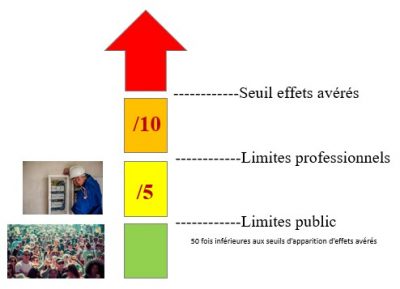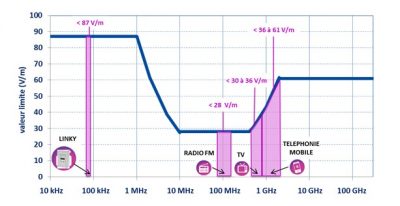Radiofrequencies, risk and regulation
PDFIn order to avoid effects on the health of users, there are regulations that set thresholds that must not be exceeded for public exposure to electromagnetic fields. These regulations are based on scientific knowledge. Only proven effects are taken into account when establishing or modifying the proposed thresholds.
1. The risk
1.1. Proven risk, proven effect
A scientifically proven risk exists when the harmful nature of a risk factor (radiation, chemical or natural product, bacteria, etc.) is demonstrated with certainty. Regardless of the field of research, a single study is not enough. The fact that it is published in a scientific journal is not in itself a guarantee of quality, even if it has a high impact factor [1]. Only epidemiological studies with a robust methodology and sufficient statistical power are truly convincing (number of cases, consideration of bias, relevance of the statistical analysis method used, etc.) [2]. The existence of a proven effect of waves on health can therefore be affirmed if it is observed in published studies whose methodology is validated for both the physical and biological parts (wave exposure system, biological experimentation, dosimetry), which could be reproduced (“replicated”) by several independent teams and whose results are consistent with each other. Inconsistent results between different studies (experimental and epidemiological in particular) or the observation of effects that are difficult to distinguish from those existing without exposure to the risk factor do not allow the conclusion of the existence of an effect or a proven risk.
1.2. There is no such thing as zero risk
The scientific method does not allow us to demonstrate that a phenomenon, whatever it may be, does not exist. In fact, the researcher starts from the hypothesis that an effect exists and tries to demonstrate it. If he fails, it is always possible that the experimental conditions chosen did not allow this demonstration. It is in fact impossible to scientifically exclude the hypothesis of the existence of an effect, which does not mean that it exists. There is therefore always a degree of uncertainty, which diminishes as more and more data are accumulated. For these reasons, it will never be possible to scientifically prove a total absence of risk!
1.3. Do not confuse risk and danger
It is useful to distinguish between risk and hazard. Risk is a concept that takes into account the probability of a hazard occurring in order to avoid it, reduce it or establish compensation (e.g. financial in the case of insurance). Its evaluation takes into account the severity of the hazard (its impact) and its occurrence, which in toxicology roughly corresponds to the level of exposure. Danger and risk are not proportional, there can be a great risk of a small danger occurring, and a small risk of a great danger occurring. For example, a lion represents a danger to humans (vignette). If you are walking in the savannah and you meet a hungry lion, the risk is high. But if you visit a zoo and walk past the lion’s cage, the risk of attack is very low… The danger is the same, but the exposure is different. The notion of exposure is fundamental to the assessment of environmental risks, particularly for regulatory management [3].
2. Regulations for the protection of people
2.1. What is the principle of regulation?
In many countries, such as Europe, the establishment of regulatory limits is based on the work of the International Commission on Non-Ionizing Radiation Protection (ICNIRP) [4], which is also a reference for the WHO [5]. This group of experts carries out a permanent bibliographic survey of the scientific data relating to the effects of non-ionizing radiation.

In France, the exposure limit values for the public to radio frequencies are set by a 2002 Decree [6 ] which covers electromagnetic fields from 0 kHz to 300 GHz. This decree takes up the values recommended by the European Commission [7], which are themselves based on the guidelines [8] proposed in 1998 by the Icnirp. For the protection of workers, it is a Decree of 2016 [9] that implements a European Directive of 2013 [10 ]; all companies are concerned [11]. As a precaution, the recommended exposure limits for the public are 50 times lower than the level of appearance of the first proven effects (thermal), in particular to take into account potentially more vulnerable populations (children, pregnant women, sick, elderly…). These limits are 5 times higher for occupational exposure (Figure 1 – Table 1).
In concrete terms, the higher the frequency, the less the waves penetrate the body.

This results in the use of different exposure indicators to establish regulatory limits. The Specific Absorption Rate (SAR) quantifies the energy absorption in depth, in watts per kilogram (W/kg). The power density quantifies the surface power density, in watts per square metre (W/m2).
In early 2020, the ICNIRP published updated guidelines for the radio frequency range from 100 kHz to 300 GHz [12]. Very briefly, the exposure limit values remain unchanged in terms of SARs, with adjustments to better accommodate future technologies with shorter exposures and higher frequencies. New exposure limit values have been defined such as the absorbed power density (Sab) to quantify surface absorption locally, in watts per square metre (W/m2). However, the ICNIRP states that the exposure values proposed in 1998 “still provide adequate protection for current technologies” and that they “will also provide protection for 5G technologies if they produce the exposure levels predicted to date; these are expected to be approximately similar to exposures from previous mobile telecommunications technologies (e.g. 4G).
2.2. How to meet the thresholds for far-end transmitters?

2.3. How to respect the thresholds for transmitters used close to the body?
Since electric field measurements cannot be relied upon very close to or in contact with the terminals, it is the equipment that must be designed to comply with the regulations. In this case, the SAR limit values are the direct reference for devices used close to the body. Thus, for each mobile phone, the SAR is measured in the factory on standardized dummies (“phantoms”) filled with a liquid mimicking biological tissue when the device is transmitting at full power. Its value must not exceed the regulatory limits of 2 W/kg for the head or trunk, and 4 W/kg for the limbs (compliance). For consumer information, the display of the SAR (head) is required since 2010 for mobile phones. During normal use of a compliant phone, this value is not actually reached because a power control system adapts the transmitted signal strength to the minimum necessary for the connection [14]. Without this, the phone’s battery would quickly run down. Since July 2020, the display requirement has been extended to all devices emitting radio frequencies with a power greater than 20 milliwatts that can be used within 20 cm of the body [15] : tablets, connected watches, Bluetooth headphones, etc.
3. Is the regulation respected?
In France, the Agence nationale des fréquences (ANFR) monitors compliance with regulations for the public as well as the conformity of equipment [16]. Mobile phones taken from the market are tested in the laboratory. In addition, the field strength measurements carried out in the country as part of the national monitoring system are available on the Cartoradio.fr website. Anyone can request free exposure measurements in a home or any other place accessible to the public [17]. According to the annual reports, the ambient exposure levels are well below the regulatory thresholds. In 2019, 50% of the measured values were below 0.38 V/m (median field) and 90% were below 1.8 V/m [18].
Notes and references
Cover images. [Source: © Jacques Joyard]
[1] A lot of information about scientific publications on the site ” La rédaction médicale & scientifique “
[2] Souques M., “Notions de base sur l’épidémiologie”, SPS n° 286, July-September 2009. On afis.org
[3] Greenfacts, video ” Danger, risk and safety ” (French subtitles: validate the option in the settings at the bottom right of the video)
[4] https://www.icnirp.org/en/home/home-read-more.html
[5] WHO, 2004, Electromagnetic fields and public health: mobile phones. On who.int
[6] Decree n°2002-775 of 3 May 2002 taken in application of 12° of article L. 32 of the code of posts and telecommunications and relating to the limit values of exposure of the public to the electromagnetic fields emitted by the equipment used in the telecommunications networks or by the radioelectric installations. Journal officiel de la République Française, 2002; 105: 8624. On legifrance.gouv.fr
https://www.legifrance.gouv.fr/affichTexte.do?cidTexte=JORFTEXT000000226401
[7] Council of the European Communities. Recommendation of the European Council of 12 July 1999 on the limitation of exposure of the general public to electromagnetic fields (0 Hz to 300 GHz)
[8] Guidelines for Limiting Exposure to Time-Varying Electric, Magnetic, and Electromagnetic Fields (up to 300 GHz). Health Physics 74 (4): 494-522; 1998.(http://www.icnirp.de/PubEMF.htm).
[9] Decree No. 2016-1074 of 3 August 2016 on the protection of workers against the risks due to electromagnetic fields. Journal Officiel de la République Française, 2016. On legifrance.gouv.fr
[10] Council of the European Communities. Directive 2013/35/EU of the European Parliament and of the Council of 26 June 2013 on the minimum health and safety requirements regarding the exposure of workers to the risks arising from physical agents (electromagnetic fields). Official Journal of the European Union 2013; L179 (29 June): 1-21.
http://eur-lex.europa.eu/legal-content/FR/TXT/PDF/?uri=CELEX:32013L0035&from=FR
[11] French Society for Radiation Protection fact sheet, Evaluating worker exposure to electromagnetic fields, 2020. On sfrp.fr
[12] ICNIRP. Guidelines for limiting exposure to electromagnetic fields (100 kHz to 300 GHz). Health Phys 118(5): 483-524; 2020.
[13] ICNIRP, “Frequently Asked Questions related to the ICNIRP RF EMF Guidelines 2020”. At icnirp.org
[14] ANFR, Actual SAR/Measured SAR (maximum). On anfr.fr
[15] ANFR, Radioelectric equipment: from 1 July, the SAR display is reinforced for better public information, 30 June 2020. On anfr.fr
[16] ANFR, Exposition du public aux ondes. On anfr.fr
[17] ANFR, Faire réaliser une mesure. On anfr.fr
[18] ANFR, Etude de l’exposition du public aux ondes radioélectriques. April 2020. On anfr.fr




